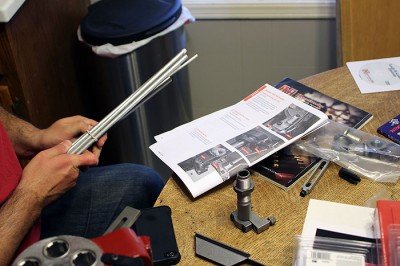
If you’ve never played with reloading, it can be a challenge. The set up of a good press is the perfect way to spend a Saturday inside. Here, we’re working with a Hornady Lock-N-Load AP. I’d clamped it to the kitchen table while we were setting it up. Bad idea. Turns out the wife wasn’t thrilled with the new addition to the kitchen.
We’ve been thinking a lot about bad weather recently, and what you can do to occupy your time. Reloading may seem daunting to some, and for good reason. It shouldn’t–there are clear cut manuals that will walk you through all of the measurements that, if ignored, make reloading dangerous. And there’s no better way to blow through an afternoon than producing a great big pile of ammo you can shoot when the clouds clear.
I’m brand new to the reloading game. I’ve been saving brass for a long time, and during the great ammo recession of 2013, I was actively scouting brass and primers for friends and acquaintances. I was striking deals with FFLs and shop managers that put Colombian cartels to shame, trafficking brass and large pistol primers in quantity. But while I was a master at sourcing components (and never once ran dry), I never assembled the ammunition myself, and I called in a lot of favors.
Yet there comes a time in everyone’s life when they have to get off the sidelines and into the game. I shoot, on average, 1,000 rounds a week. There are times when this is lower, and sometimes I will run 1,000 in a long weekend, but I shoot a lot. I’m not relegated to one caliber, either, so I wanted a reloading setup that would allow me to switch between calibers easily. The Hornady Lock-N-Load AP seemed a logical place to start. It is a cast aluminum, auto indexing press with five stages.
I thought I would unbox this thing and be on the range with a mess of .45 ACP that afternoon. Nope. Set-up is serious business. I’ve discovered that there are several learning curves one has to get over on the way to functional ammo. And the first one you’ll find with the Lock-N-Load is the set up of the progressive stations.
Each of the caliber-specific components locks into the press in a modular fashion. If you want to set up the whole press for .45 ACP, reload a batch, then move to .308, you don’t have to scrap the settings for your .45 ACP. Just removes those components and set up for .308. Once your set-up for each caliber is complete, changing them over is incredibly fast.
How long does set-up take?
Well–how many licks does it take to get to the center of a Tootsie-Pop? The world may never know. Actually, I’d say it depends on your skill set. From the time we opened the box until we got our first functioning .45 ACP reload was about 4 hours, give or take. And there were two of us monkeys working on it.
[full_width]
[/full_width]

After several attempts, we got the .45 ACP components cooperating nicely. We’re .004 of an inch off of our target mark.
We ran some test brass, then ran some more. We would get the primers set, then move on, sequentially, station by station, until we had everything right. In between, we would pull the brass and check specs, and try it all again. This station does everything except clean the brass, so there’s a lot to get right. We loaded brass by hand, and then the press de-primed, primed, sized, added powder and capped it off with a bullet. Pull the arm like you would on a slot machine and the press makes half a rotation. Let it go and it completes the movement.
Hornady says the press can produce 500 rounds in an hour. That’s faster than I usually shoot them, so I’m all in. I’m not there yet. In fact, I haven’t tested the first rounds. But I’ll get there.
In the meantime. Anyone out there proficient with the Hornady Lock-N-Load? If so, what was your experience with initial set up times? And does it get faster as you learn the proverbial ropes? Share your experiences below….
[one_half]

The lock and load part of the Lock-N-Load is easy to understand. The dies twist in and lock into the press.
[/one_half][one_half_last]

These die bushings allow you to set up modular components for various calibers, or even different bullet shapes.
[/one_half_last]
[one_half]

Because this press has tight spaces with limited access, some photos aren’t as clear as I’d hope. But, we figured it out. And YouTube has a wealth of extra help. If that’s not enough, there’s a DVD included.
[/one_half][one_half_last]

Be sure your work space is clear and easy to organize. And ask your wife if she minds you clamping it to the table. Odds are she does. Seriously, though, don’t do what we did–set it up where it needs to be. And bolt that sucker down.
[/one_half_last]
[one_half]

The powder dispenser may be the most daunting part. This is, after all, the one thing you shouldn’t screw up.
[/one_half]

